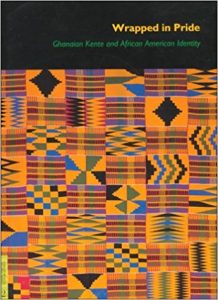
WRAPPED IN PRIDE Ghanaian Kente and African American Identity A Curriculum Resource Unit Lyn Avins and Betsy D. Quick UCLA Fowler Museum of Cultural History, Los Angeles, 1998. 162 pp., 20 color slides. $40 soft-cover.
This curriculum resource unit for teachers was developed in conjunction with the traveling exhibition of the same name, organized by the UCLA Fowler Museum of Cultural History (catalogue reviewed on p. 13). It is divided into four spiral-bound sections, which are followed by rich appendixes that include a poem by W. E. B. Du Bois, a kente-weaving song, a bibliography, glossaries, and extensive notes on the beautiful slides that accompany the publication.
The introduction provides brief yet comprehensive information on the Asante people of Ghana and an overview of the exhibition, whose 700 objects encompass individual works of art and many others “employed in recreated market environments as found in Ghana and the United States” (p. 11). The exhibition comprises several sections: The Weaving of Kente, The Market, The Wearing of Kente, The Fine Art of Asante Kente, The Fine Art of Ewe Kente, The Colors of African Unity, From Kente to Quilts, A Calendar of Cloth, and Portraits of Kente, which show prominent African American leaders wearing the cloth.
This resource unit is built around twenty colorful slides and a plethora of black-and white photographs scattered throughout the various sections. Unit 1, “The Leader, the People, the Nation,” provides an extensive general history of Ghana and the Asante kingdom and its leaders and leadership arts.
In unit 2, “The Making and Design of Kente Cloth,” Avins and Quick chronicle the evolution of the Asante and Ewe weaving and describe the delicate and time-consuming processes of putting the cloth together. The four distinct tasks that accompany kente weaving are explained in detail: winding threads into skeins and laying them out in the desired color pattern; threading the loom with the prepared warp threads; weaving the cloth to the desired length; and, finally, sewing the narrow strips together. Thorough descriptions of various warp-stripe patterns and weft designs are enhanced by images depicting the weaving process, which facilitate one’s understanding and appreciation.
Unit 3, “The Contexts of Kente Use in Ghana,” is replete with examples: the Adae Kesee, or the procession of the Asantehene and other paramount or divisional chiefs; durbars, or public audiences at the courts of local or paramount rulers, where the most important chiefs are carried around in palanquins; installations and funerals of chiefs; palanquin linings; gift giving from historical times to the present, as witnessed by the presentation of kente to England’s Princess Mary on the occasion of her wedding and more recently to the Clintons on their visit to Ghana. The continuing commercialization of the cloth has led to its use in baseball caps, backpacks, ties, shoes, bags, purses, and other accessories.
Unit 4, “The Pan-African Movement and Kente in the United States,” extends its view beyond Ghana. Clad in kente, Kwame Nkmmah and his entourage visited Washington in 1958 and 1960, when Eisenhower was president. When W. E. B. Du Bois received his honorary degree at the University of Ghana, Legon, in 1963, he donned an exquisite kente-based academic gown. In the United States, the cloth has become an integral part of the lives of African Americans, woven into events like Kwanzaa celebrations, Martin Luther King Day, Black History Month, and graduation at all levels. The conspicuous display of kente testifies to the widespread use and symbolism of this textile, once the “exclusive prerogative of Asante or other Akan chiefs” (p. 20).
This book is truly a rich resource that goes beyond kente; it is also a useful tool for teaching history and comparative cultures. The thought-provoking questions that begin each unit, the outlined activities, and the discussion in each lesson within the units will challenge and stimulate students. At the same time, such additions as proverbs, folktales, and descriptions of cultural activities like naming ceremonies make this a truly enjoyable publication. The names and the messages of the ten different kente patterns on the accompanying poster itself are a mine of lifelong learning. The Wrapped in Pride curriculum resource unit and its activities should be a mandatory addition to all lessons on African studies, especially since kente continues to be an integral part of the lives of African Americans. strongly recommend this book for libraries of all kinds.
KWASI SARKODIE-MENSAH is manager of instructional services at the O’Neill Library at Boston College, where he is also an Adjunct Professor in the College of Advancing Studies.